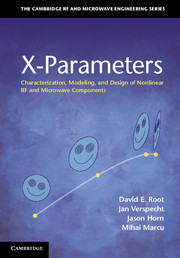Book contents
- Frontmatter
- Contents
- Preface
- Acknowledgments
- 1 S-parameters – a concise review
- 2 X-parameters – fundamental concepts
- 3 Spectral linearization approximation
- 4 X-parameter measurement
- 5 Multi-tone and multi-port cases
- 6 Memory
- Appendix A Notations and general definitions
- Appendix B X-parameters and Volterra theory
- Appendix C Parallel Hammerstein symmetry
- Appendix D Wide-band memory approximation
- Appendix E Solutions to exercises
- Index
- References
6 - Memory
Published online by Cambridge University Press: 05 October 2013
- Frontmatter
- Contents
- Preface
- Acknowledgments
- 1 S-parameters – a concise review
- 2 X-parameters – fundamental concepts
- 3 Spectral linearization approximation
- 4 X-parameter measurement
- 5 Multi-tone and multi-port cases
- 6 Memory
- Appendix A Notations and general definitions
- Appendix B X-parameters and Volterra theory
- Appendix C Parallel Hammerstein symmetry
- Appendix D Wide-band memory approximation
- Appendix E Solutions to exercises
- Index
- References
Summary
Introduction
X-parameters were introduced in Chapter 2 as frequency-domain nonlinear mappings. The X-parameter functions are defined on the complex amplitudes of the incident CW signals, returning the complex amplitudes of the scattered CW signals. For fixed power, bias, and load conditions, these input and output amplitudes are constant (in time) complex numbers. As such, X-parameters were defined only for steady-state conditions.
Real applications deal with signals that vary in time and the corresponding time-varying responses of DUTs to such stimuli. In particular, signals used in wireless communications can have independent time-varying values for the amplitudes and phases associated with each of the multiple carriers involved. These time-dependent modulations contain the information associated with the signal. Much of communication systems design is devoted to trying to preserve the information content of these signals while efficiently amplifying, transmitting, and then demodulating them at the receiver to recover the information.
This chapter introduces the notion of dynamics into the signals and into the mappings between input and output stimuli that define the DUT as a nonlinear dynamic system. The envelope domain is introduced to define the class of signals considered. Quasi-static applications of static X-parameters are introduced as methods for estimating the DUT’s response to modulated signals, and limitations are discussed. Examples are provided of phenomena that require the abandonment of the static nonlinear system description. This introduces the notion of memory, where the response of the system depends not only on the instantaneous value of the input signal, but also on the history of the input signal. The concept of modulation-induced baseband memory is articulated.
- Type
- Chapter
- Information
- X-ParametersCharacterization, Modeling, and Design of Nonlinear RF and Microwave Components, pp. 150 - 188Publisher: Cambridge University PressPrint publication year: 2013



